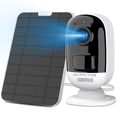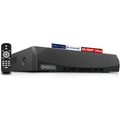Maintenance and Management of Security Surveillance Systems: An OHWOAI Perspective
Introduction
Effective maintenance and management of security surveillance systems are crucial for ensuring their longevity, reliability, and operational effectiveness. OHWOAI, a leading brand in the security industry, places great emphasis on providing comprehensive maintenance services to guarantee the continuous and optimal performance of surveillance equipment. This article will delve into the best practices for maintaining and managing security surveillance systems, highlighting OHWOAI's commitment to excellence.
Maintenance of Security Surveillance Systems
- **Routine Maintenance Responsibilities**
To ensure the seamless operation of surveillance equipment, daily monitoring, maintenance, and management of the system are imperative. OHWOAI takes on the responsibility of maintaining the equipment to ensure its prolonged and dependable operation.
- **Preventive Measures**
During the maintenance process, it's essential to take preemptive actions to ensure smooth equipment operation. Measures should be taken to prevent moisture, dust, and corrosion, which can hinder the functioning of surveillance equipment.
- **Regular Cleaning and Inspection**
Regular cleaning and dusting of the surveillance equipment are essential to maintain optimal performance. Cameras and protective covers should be carefully cleaned, and lenses should be wiped down with alcohol wipes to ensure clarity and prevent dust accumulation. Simultaneously, ventilation, cooling, and dust prevention facilities in the monitoring room should be inspected.
- **Timely Replacement of Aging Components**
Components prone to aging should be inspected on a monthly basis. If any signs of deterioration are detected, prompt replacement or repair should be carried out to ensure uninterrupted operation.
- **Periodic Cleaning of Dust-prone Areas**
Areas susceptible to dust accumulation, especially monitors exposed to open air, should be cleaned quarterly. Regular dusting and calibration of monitors' color and brightness settings are crucial to maintain image quality.
- **Regular Maintenance of Long-Running Equipment**
Equipment that operates for extended periods, such as hard disk recorders, should be maintained monthly. Ensuring the proper functioning of components like cooling fans prevents abnormal operation due to overheating.
- **Ongoing Monitoring and Analysis**
Continuous monitoring and analysis of the surveillance system's performance are essential to detect and resolve issues promptly.
Standard Procedures for Inspection and Maintenance of Security Surveillance Systems
- **Control Console**
- Ensure normal operation of control console components, including switching and scanning capabilities.
- Verify the flexibility and reliability of the operating keyboard.
- Confirm the functionality of the power lock switch.
- **Display Screens**
- Ensure all monitors on display screens are intact, functional, and display clear images as per design requirements.
- Check for clear wiring connections and no loose wiring.
- Confirm secure and reliable monitor installation.
- **Power Equipment**
- Verify the stability and proper functioning of the AC stabilizer power supply.
- Ensure appropriate configuration of fuses in output circuits.
- Maintain clear separation between AC and DC power sources, with no loose connections.
- Test the reliability of dual-power source switching.
- Verify equipment grounding protection and overall safety measures.
- **Cameras**
- Confirm proper operation and availability of all cameras.
- Test the adjustability of cameras with variable focal lengths to meet performance requirements.
- Ensure all cameras have protective covers, especially for outdoor models.
- Calibrate lens apertures for clear imaging as per design requirements.
- **Recorders**
- Verify the availability and proper performance of all recorders, meeting performance requirements.
- Confirm the recording capability of all monitoring points' signals onto the recorders.
- **Security and Anti-Theft Systems**
① Verify communication between the intercom device in elevators and the control center.
② Electronic anti-theft doors:
- Check the functionality of the door closer switch, ensuring clear open and close cycles, with automatic locking upon closure.
- Verify proper operation of electronic keypad locks, including the ability to modify passwords.
- Inspect the keypad for damage and leaks.
- Confirm the availability of power.
- Ensure compliance with grounding protection regulations.
- **Building Surveillance System**
① Emergency power supply for UPS:
- Validate output voltage data, ensuring it matches equipment specifications.
- Ensure an appropriate power capacity without overloading, with matching fuses.
- Confirm the availability of standby power, adequate battery capacity to sustain power for the required duration, and reliable and rapid switching capabilities.
- Verify compliance with grounding protection regulations.
- Ensure reliable contacts without oxidation.
- Keep the exterior free from dust.
② Input/Output Controllers:
- Confirm reliable connection of all electrical contacts.
- Inspect electrical panels for cleanliness and absence of oxidation.
- Validate input/output signals.
③ Actuators (electromagnetic valves, air valves, converters, etc.):
- Verify correct and reliable operation.
- Ensure mechanical components are clean, free from dust and oxidation.
- Validate data signals from temperature, pressure, and flow sensors, ensuring the absence of dust and oxidation on their surfaces.
Maintenance Considerations for Security Surveillance System Equipment
During the maintenance of security surveillance system equipment, several factors, including moisture prevention, dust control, corrosion protection, lightning prevention, and interference prevention, need to be addressed.
- **Moisture, Dust, and Corrosion Prevention**
To enhance the equipment's inherent moisture resistance, the placement of devices should be optimized. Additionally, adequate dehumidification measures should be implemented in high humidity zones to combat moisture-related issues.
- **Lightning and Interference Prevention**
Lightning protection measures must be rigorously applied during maintenance to prevent potential damage caused by electrical surges. Proper grounding systems, following equipotential bonding schemes, are essential to mitigate interference and ensure the stability of weak electrical systems. Avoid mixing weak electrical grounding with power grounding to prevent interference from power networks.
Integration of Power over Ethernet (PoE) Switches
OHWOAI recognizes the importance of PoE technology in modern surveillance systems. The integration of PoE switches, such as 24-port PoE switches, 5-port PoE switches, and 2-port PoE switches, enhances the efficiency of power delivery to surveillance devices. These switches ensure seamless data transmission and power supply over a single Ethernet cable, simplifying installation and reducing the need for additional power outlets.
Conclusion
Maintaining and managing security surveillance systems is a multifaceted task that requires attention to detail and adherence to industry standards. OHWOAI's dedication to excellence is evident in its commitment to routine maintenance, adherence to inspection standards, and preventive measures against various challenges. By incorporating advanced technologies like PoE switches, OHWOAI continues to enhance the reliability and efficiency of its security surveillance solutions.
Sample Block Quote
Nam tempus turpis at metus scelerisque placerat nulla deumantos sollicitudin delos felis. Pellentesque diam dolor an elementum et lobortis at mollis ut risus. Curabitur semper sagittis mino de condimentum.










